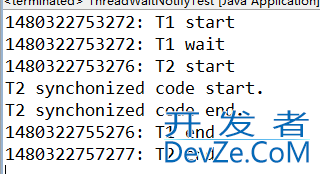目录
- 1. 创建线程
- 1.1 通过构造函数:public Thread(Runnable target, String name){} 或:public Thread(Runnable target){}
- 1.2 直接实现Runnable接口:
- 2. 运行线程
- 3. sleep
- 4. getName() 获取线程名字, getId()获取线程id
- 5. 编程客栈停止线程,
- 6. 等待和通知
- 7. 线程优先级
- 8. 守护线程
1. 创建线程
1.1 通过构造函数:public Thread(Runnable target, String name){} 或:public Thread(Runnable target){}
示例:
Thread thread1 = new Thread(new MyThread(), "mythread");
class MyThread extends Thread(){
public void run(){
System.out.println("My First Thread');
}
}
1.2 直接实现Runnable接口:
示例:
Thread thread2 = new Thread(new Runnable{}{
public void run(){
System.out.println("This is my thread.");
}
});
2. 运行线程
thead1.start()
3. sleep
try{
#休眠1000ms
Thread.sleep(1000);
}catch(InterruptedException e){
e.printStackTrace();
}
4. getName() 获取线程名字, getId()获取线程id
System.out.println(Thread.currentThread().getName() + ":"+ Thread.currentThread().getId);
5. 停止线程,
千万不用stop(),stop会立即终止线程。
通过interrupt()中断线程,但是中断并没有停止线程,配合异常来实现:
public class Main {
public static void main(String[] args) throws InterruptedException {
try{
Thread thread1=new Thread(new TheThread(),"thread1");
thread1.start();
Thread.sleep(2000);
thread1.interrupt();
}catch (InterruptedException e){
e.printStackTrace();
}
}
}
class TheThread extends Thread{
public void run() {
super.run();
for (int i = 0; i < 10; i++) {
if(this.interrupted()){
android break开发者_Python教程;
}
System.out.println(Thread.currentThread().getName() + ":" + i);
}
}
}
注意,如果在TheThread类里加入catch InterruptException的话,可能会导致interrupt被捕获,而绕过if(this.interrupted())的判断而无法终止线程。
6. 等待和通知
线程等待:当前线程就处于等待状态,直到其他线程调用了notify()方法,线程才会继续执行
public final void wait() throws InterruptedException
线程通知:
public final native void notify()
注意:在notify()方法后,当前线程不会马上释放该对象锁,要等到执行notify()方法的线程将程序执行完,也就是退出同步代码块中。
package wait.notify;
public class ThreadwaitNotifyTest {
final static Object object=new Object();
public static class T1 extends Thread{
public void run(){
System.out.println(System.currentTimeMillis()+": T1 start");
synchronized (object){
try {
System.out.println(System.currentTimeMillis()+": T1 wait");
object.wait();
} catch (InterruptedException e) {
e.printStackTrace();
}
}
System.out.println(System.currentTimeMillis()+": T1 end");
}
}
public static class T2 extends Thread{
public void run(){
System.out.println(System.currentTimeMillis()+": T2 start");
synchronized (object){
System.out.println("T2 synchonized code start.");
object.notify();
try {
Thread.sleep(2000)编程;
} catch (InterruptedException e) {
e.printStackTrace();
}finally{
System.out.println("T2 synchonized code end.");
}
}
try {
Thread.sleep(2000);
} catch (InterruptedException e) {
e.printStackTrace();
}
System.out.println(System.currentTimeMillis()+": T2 end");
}
}
public static void main(String[] args){
Thread thread1=new T1();
Thread thread2=new T2();
thread1.start();
thread2.start();
}
}
输出结果:

7. 线程优先级
高优先级的线程将会获得更多的CPU资源。一共分为10个优先级。
public final void setPriority(int newpriority)
源码分析:
public final void setPriority(int newPriority) {
ThreadGroup g;
checkAccess();
if (newPriority > MAX_PRIORITY || newPriority < MIN_PRIORITY) {
throw new IllegalArgumentException();
}
if((g = getThreadGroup()) != null) {
if (newPriority > g.getMaxPriority()) {
newPriority = g.getMaxPriority();
}
setPriority0(priority = newPriority);
}
}
public final static int MIN_PRIORITY = 1; public final static int NORM_PRIORITY = 5; public final static int MAX_PRIORITY = 10;
可见线程最高优先级为10, 最低为1, 默认为5.
当设定的newPriority高于该线程组ThreadGroup的最高Priority时,只能分配该线程组的最高Priority
8. 守护线程
类似守护进程,Java存在两种线程:用户线程和守护线程。它是一种特殊线程,执行的是一种后台服务,当一个系统中不存在非守护线程的时候,守护线程会自己销毁。典型的守护线程:JVM的垃圾回收线程。
public final void setDaemon(boolean on)
示例:
public class Main {
public static void main(String[] args) throws InterruptedException {
TheThread theThread=new TheThread();
theThread.setDaemon(true);//设置守护线程
theThread.start();
Thread.sleep(5000);
System.out.println("全都退出啦");
}
public static class TheThread extends Thread{
public void run(){
int i = 0;
while (true){
i++;
System.out.println(Thread.currentThread().getId()+":"+i);
try {
Thread.sleep(2000);
} catch (InterruptedException e) {
e.printStackTrace();
}
}
}
}
}
源码分析:
设置线程为用户线程(user thread)或守护线程(daemon thread),当剩余运行的线程均为守护线程时,JVM会退出。
public final void setDaemon(boolean on) {
checkAccess();
if (isAlive()) {
throw new IllegalThreadStateException();
}
daemon = on;
}
其中checkAccesss()方法如下:
public final void checkAccess() {
SecurityManager security = System.getSecurityManager();
if (security != null) {
security.checkAccess(this);
}
}
js该方法用于判断当前运行的线程是否有修改此线程的权限。
而public final native boolean isAlive();用于判断该线程是否处于alive状态,即该线程是否已经start,且没有die。
当isAlive的话就会抛出IllegalThreadStateException异常。
所以,设置守护线程的方法,逻辑就是先判断当前线程是否有修改的权限,再判断是否处于alive状态,如果不处于alive状态,则根据boolean变量on的值更改它http://www.devze.com的状态,即true:设为daemon线程,false:设为user线程。
到此这篇关于Java多线程基础学习的文章就介绍到这了,更多相关Java多线程基础内容请搜索我们以前的文章或继续浏览下面的相关文章希望大家以后多多支持我们!









 加载中,请稍侯......
加载中,请稍侯......
精彩评论